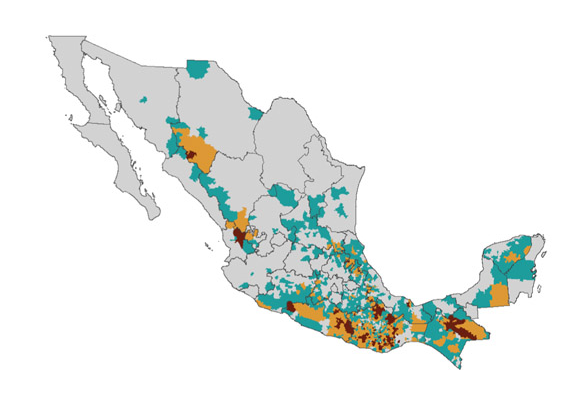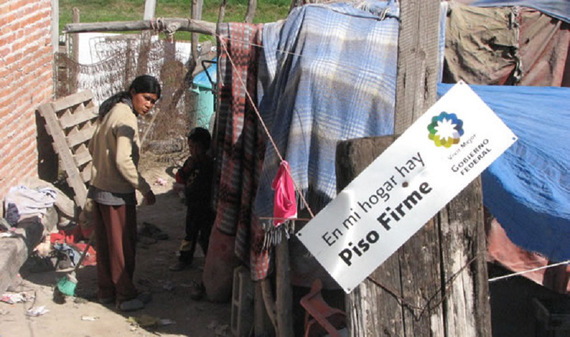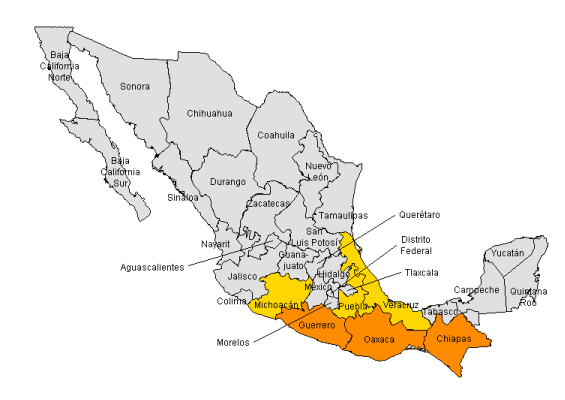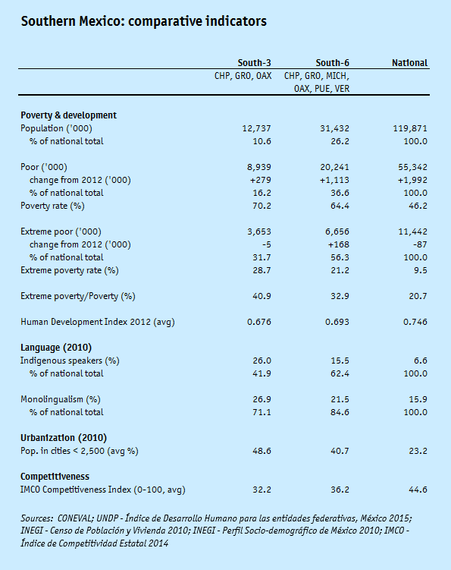Between the recent data on poverty released by the CONEVAL, and an earlier Oxfam report on inequality, Mexico's progress on the socio-economic front has given little to brag about in recent years. According to CONEVAL, poverty is once again on the rise as 2 million Mexicans descended into the ranks of the poor between 2012 and 2014, resulting in an embarrassing national poverty rate of 46.2% (an older methodology puts it higher, at 53.2%). Making things worse, Oxfam's inequality report (authored by a highly renowned Mexican economist, Gerardo Esquivel) offers some depressing reading on the state of wealth inequality in the country:, the richest 1% of the Mexican population receive no less than 21% of total income, a share that exceeds that of the US and UK, and the country's 145,000 millionaires concentrate around 43% of total national wealth.
As startling as the national numbers are, there is a huge disparity in socio-economic performance among Mexico's 32 sub-national entities (31 states and the Federal District), which makes the issue of geographical inequality just as worrying. It is well known that the three southern states of Guerrero, Oaxaca, and Chiapas have the highest poverty rates in the entire country, partly (but not entirely) as a result of their high indigenous populations which according to the Oxfam report suffer from poverty levels four times higher than the national average. Aside from these three, there is also a second tier of southern states whose socio-economic indicators are far below the national average. This group includes drug-ridden Michoacán, the Gulf of Mexico state of Veracruz, and also Puebla. Together, these six states represent around a quarter of Mexico's population but 37% of its poor and 57% of its extreme poor. They also account for over half of the 2 million Mexicans who fell into poverty between 2012 and 2014. If any serious attempt at solving Mexico's socio-economic failures is to take place, it must necessarily begin here.
Mexico's troubled southern states
The statistics of misery
The three poorest states, Guerrero, Oaxaca, Chiapas (herein referred to as the South-3) are in a league of their own when it comes to sheer misery. A staggering 70.2% of their populations were poor in 2014, a scandalous number for an OECD economy. The rate of extreme poverty is also three times higher than the national average (28.7% versus 9.5%); 3 out of 10 of Mexico's total number of extreme poor live in these states. As mentioned above, one of the factors that appears to drive poverty in this state is its large indigenous population. Mexico's statistics institute (INEGI) unfortunately does not collect racial/ethnic data in its census but data on indigenous language speakers can be used as a proxy even if it underestimates the true numbers. According to the latest census, these three states (especially Oaxaca and Chiapas) have some of the highest proportions of indigenous language speakers in the country. As we will see later, however, this alone is not a convincing explanation for their poverty levels.
Adding the other three states, Michoacán, Puebla, and Veracruz we have the South-6, a territory of 31 million people of which 64% are in poverty and 21% are in extreme poverty. All of these states have a poverty rate of over half their population, of which ostensibly "affluent" Puebla has the surprisingly highest at 64.5% - not far below Guerrero and Oaxaca (its extreme poverty rate of 16.2% is also the fourth highest nationally). One of the key statistical characteristics of the South-7 is its high share of extreme poverty relative to total poverty, which suggests that there are unique structural factors within the South-6 that are driving extreme poverty beyond the level that the total poverty rate would suggest. The South-3 has share of extreme poor relative to total poor of over 40% which is twice the national average, whereas for the South-6 the share is 33%. In contrast, the more prosperous northern and central states as well as the Federal District have this share near or below the 10% mark.
If a 60%+ poverty rate is not bad enough, the result of some individual municipalities is even worse. According to 2010 data from CONEVAL (the most recent at this level), nine out of the ten poorest municipalities were in either Chiapas or Oaxaca, the only outlier being a municipality in Veracruz. All of these had poverty rates of over 96%, a state of near total marginalization. How such absurdly high levels of poverty persist well into the 21st Century despite the existence of conditional cash transfers since the 1990s (the Progresa/Opportunidades/Prospera programs) should prompt some serious reconsideration over these programs' true effectiveness.
Extreme poverty by municipality

Source: CONEVAL (green: > 20%, yellow: > 40%, dark red: >60% extreme poverty rate)
Why is southern Mexico worse off?
The fact that these states, particularly the South-3, have such large indigenous communities suggests that this is one of the main reasons why they rank so badly in socio-economic terms. But the fact that the three states in the Yucatan peninsula have similarly high indigenous populations (over one in five is an indigenous language speaker compared to one in four in the South-3) suggests that the real causes for the South-3's underperformance lie elsewhere.
There is one key statistic that separates the indigenous populations between these two regions and that is their level of monolingualism; that is, the amount of people who speak only one language. Among the South-3's indigenous population, the level of monolingualism is considerably higher than that of the peninsula: 26.9% compared to just 6.7%. It could well be that the reason behind Yucatan's lower levels of marginalization is that it has done much better at integrating its indigenous population to the modern economy, possibly as a result of its world-class tourism industry as well as the fact that the peninsula has a much more benign topography that inhibits isolation (it is essentially flat, and its large tracts of jungle are mostly uninhabited). There is also a more homogeneous distribution of language: practically all its indigenous inhabitants are Mayans who speak the Yucatec branch of Mayan. In contrast, there are 5 major languages spoken in Chiapas of which the two largest (Tzotzil and Tzeltal; both Mayan derivatives but which are unintelligible to each other) are spoken by only around a third of the indigenous population each. Oaxaca has an even greater ethnic and linguistic diversity. As recent evidence seems to suggest, linguistically homogenous countries tend to do better so this could better explain the difference in socio-economic outcomes.
The issue of topography in the South-3 (and to a large part of the South-6) is also a major factor in explaining the sub-standard infrastructure in the region. All these states run through one of three major mountain ranges - the Sierra Madre del Sur (Michoacán, Guerrero, and Oaxaca), the Sierra Madre de Chiapas (Chiapas), and the Trans-Mexican Volcanic Belt (Puebla and Veracruz) - which makes communicating the thousands of small rural communities extremely expensive, thereby reinforces their isolation from modern markets. Lack of opportunities in the region's major cities could also be holding back migration from rural to urban areas, where productivity would be higher if good jobs were there. The South-6 has some of Mexico's lowest levels of urbanization: over 50% of the population in Oaxaca and Chiapas live in villages of under 2,500 people; in Guerrero and Veracruz it is around 40%; and in Michoacán and Puebla around 30% (in Puebla's case, this is largely to do with the size of its capital, which at nearly 3m is Mexico's fourth largest city - the rest of the state is overwhelmingly rural). In all cases this is well above the national average.
The poor vote
A final common denominator among these states is the recurrence of bad governments. Some of the worst state governments in recent memory have been found in the South-6 which include a governor nearly overthrown by protesting teachers (Ulises Ruiz of Oaxaca, 2004-10), one that has increased his state's debt by a factor of 18 during his term and with little to show for it (Juan Sabines of Chiapas, 2006-12), one who came two Supreme Court votes away from a possible impeachment (Mario Marín of Puebla, 2005-11), and one that has presided over the greatest number of journalist murders of any other state in the last decade (Javier Duarte of Veracruz, 2010-). Then of course are the recent cases of Ángel Aguirre (2011-14) in Guerrero who was dismissed (a rarity in Mexico) due to his poor handling of the Ayotzinapa kidnappings, as well as Fausto Vallejo in Michoacán who proved incapable of managing his state's near-complete institutional breakdown in 2013-14 following the creation of self-defense militias (autodefensas) to fight the drug cartels due to the failure of local security forces to do their part.
It is painfully obvious that that these governments have also profited from having masses of poor as fodder for their parties' voting machines, as the recent experience in Chiapas (governed by the PVEM's Manuel Velasco since 2012) demonstrates. Local elections held in that state in early July were among the most lopsided in recent memory, with the PVEM and its allies winning 108 out of 122 municipalities and all 24 local electoral districts despite the fact that a decade earlier the PVEM controlled just 4% of municipalities. Furthermore, electoral authorities received over 200 complaints of fraud. Velasco's lavish spending on self-promotion in a state where over three-fourths of the population is under the poverty line is also telling of his government's real priorities. If anything has characterized Mexico's electoral democracy over the past century is the ease in which political parties can convince (and coerce) a poverty-stricken population to vote for one bad politician after another. In Mexico, "managing" poverty has proven to be a far more lucrative business for the political establishment than eradicating it.
Is there a way out?
In light of Southern Mexico's socio-economic shortcomings, the obvious solution would be a massive influx of public resources to begin reversing the gap in socio-economic outcomes with the rest of the country starting by modernizing the region's infrastructure. Given Mexico's tight fiscal outlook for the next few years, prioritizing spending into this region is essential and one has to question whether some of the administration's mega-projects such as Mexico City's new airport or the Mexico City-Queretaro bullet train (now cancelled but which could possibly be revived at some point in the not-so-distant future) are really the best use of limited public resources since they will hardly benefit those in greatest need. Dozens of new, paved rural highways or schools for indigenous communities may not grace glossy magazine covers the way a Norman Foster-designed airport terminal would but the latter won't do much to bring people out of poverty. The government has recently pledged assistance to the South-3 plus Michoacán in the form of "special economic zones", but the resources offered are meager (550 million pesos, or $33 million USD, equivalent to just 0.003% of GDP) compared to what is truly required: a veritable Marshall Plan for southern Mexico that is uncompromising with regards to the scale of resources used to bring this part of Mexico into the 21st century.
For this to work, Mexico's public transfers model needs to change. As it is, vast federal resources are assigned to inefficient (and usually corrupt) state and local governments but the lack of accountability and transparency at these levels practically guarantees that a large share of these resources will ultimately be misused at best, or siphoned off at worst. These funds are a substantial share of total public spending: according to think tank IMCO, 45.6% of total spending by the public sector was undertaken by states and municipalities despite only raising 9.6% of revenues. Unfortunately, this classic method of distributing largesse has provided symbiotic benefits to both federal and sub-national governments - even when these are not of the same party - since the opposition feels less inclined to take a stand on corruption when it is benefitting just as much from it. This makes it highly unlikely that there will be any meaningful effort to establish more effective sub-national mechanisms for accountability and transparency, investigate and punish corrupt officials, or -in extreme cases - for the federal government to "take over" states when rampant corruption (often coinciding with extreme drug-related violence) has all but eroded effective governance. It does not help either that the federal government is suffering from a crisis of credibility of its own, which could make it less inclined to fully implement some of its new oversight powers provided by recent reforms.
That advanced car and aerospace factories can coexist with subsistence farming in the 21st century, and that some municipalities can have the incomes of a European country while others suffer from deprivation on a scale similar to sub-Saharan Africa, is a telling failure of the country's development model and highlights the fact that geographical inequality in Mexico cannot be ignored. Only a massive allocation of resources that can be somehow ring-fenced from government misuse will help rewrite the story of southern Mexico - one of Mexico's most physically beautiful and culturally diverse - from one of failure to one of prosperity.
(Don't expect it this term, though.)
Follow the author @raguileramx



